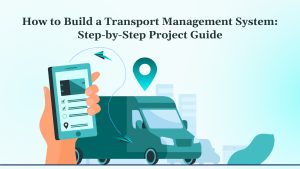Scaling a SaaS product means dealing with moving targets, tight deadlines, shifting specs, and growing tech debt while keeping performance and uptime intact. Teams are expected to deliver stability, speed, and scalability, all at once.
Most failures trace back to the exact root causes: vague planning, weak architecture, and misaligned execution. Without a defined development process, products stall long before reaching product-market fit.
SaaS development, executed with structure and clarity, is the key to solve these challenges. This guide breaks down how to approach each SaaS development phase, from initial strategy to long-term growth, and build software that drives real business outcomes.
Key Takeaways
- SaaS development requires upfront alignment across product goals, technical architecture, and compliance standards.
- Your tooling and infrastructure decisions directly impact delivery speed and ability to scale.
- Skipping steps early, planning, QA, and deployment lead to delays, instability, and tech debt later.
- Real value comes after launch through continuous monitoring, updates, and customer support.
- Teams that adopt AI agents, API-first design, and low-code frameworks build faster and stay ahead.
Understanding SaaS: The Foundation of Modern Business Solutions
SaaS (Software as a Service) is a delivery model where applications are hosted by a provider and made available to users over the internet. Instead of installing software on individual systems or managing physical servers, users access the product through a browser or API. The provider handles everything: servers, storage, updates, security, and uptime.
This model removes the need for upfront infrastructure. Teams can start using the software immediately, without waiting for local deployment or configuration. It also ensures that all users access the same version of the product, which simplifies support and reduces compatibility issues.
From a business standpoint, SaaS improves cost predictability. Instead of large capital expenses, companies pay a recurring fee tied to usage or seats. It also shifts the burden of maintenance and scalability to the provider, freeing internal teams to focus on core priorities instead of infrastructure.
SaaS delivers more than convenience. It enables faster deployment, higher reliability, and leaner operations, making it a core part of how modern businesses build and scale digital products.
How Does SaaS Work?
SaaS applications use a multi-tenant architecture, where a single software instance serves multiple customers. Each tenant’s data and configurations are logically separated using database schemas, access controls, and encryption to ensure privacy and performance isolation.
Access controls, such as role-based permissions, session management, and encryption, enforce strict boundaries, ensuring that one tenant cannot view or interfere with another’s data, even under high traffic or concurrent usage.
When users log in, the system authenticates them and securely isolates their data, even though thousands of users might be accessing the platform simultaneously. Delivery typically happens through secure web browsers, with many platforms also offering mobile apps or APIs for integration.
This architecture allows for efficient use of resources and simplified maintenance. Updates roll out to everyone instantly. Security patches protect all tenants simultaneously.
Now that we’ve broken down how SaaS works and why it’s valuable, let’s look at what building for SaaS actually entails and how it differs from conventional web development.
Defining SaaS Development
SaaS development involves building cloud-native applications designed for subscription-based delivery and continuous operation. Traditional software often grows into complexity. SaaS, by contrast, is architected from the start to manage scale, shared infrastructure, and high availability as default requirements.
Traditional Web Applications vs SaaS Applications
SaaS development starts with the assumption of scale. From infrastructure to delivery pipelines, every layer must support frequent updates, tenant isolation, and uptime targets while avoiding complexity that slows teams down.
The table below outlines key differences between SaaS development and web development across architecture, scalability, deployment, and compliance:
| Aspect | Traditional Web Applications | SaaS Applications |
| User Base | Typically built for one organization | Built to serve multiple tenants simultaneously |
| Data Isolation | Basic user permissions | Full tenant-level data isolation |
| Architecture | Single-tenant, simpler stack | Multi-tenant, complex partitioning |
| Scalability | Manual or scheduled scaling | Auto-scaling, cloud-native infrastructure |
| Deployment | Updates may require downtime | Zero-downtime continuous deployment |
| Security | Organization-specific policies | Shared responsibility with strict compliance |
| Features | Basic functional requirements | Includes billing, onboarding, analytics, compliance, etc. |
| Compliance | Ad hoc or minimal | Built-in and auditable from day one |
Understanding the structural differences is just the start. To move ahead, it’s important to know why organizations choose to invest in SaaS development, and what specific advantages it brings when executed the right way.
Strategic Benefits of SaaS Development

Here’s how SaaS development sets the groundwork for long-term product stability, faster delivery, and smarter scaling, broken down across six core pillars:
Streamlined Deployment and Updates
SaaS applications eliminate the complex deployment challenges associated with traditional software distribution. Instead of coordinating installations across multiple client environments, SaaS providers deploy updates centrally, ensuring all users immediately access the latest features and security patches.
This centralized deployment model dramatically reduces time-to-market for new features while eliminating version fragmentation issues. When healthcare organizations need new compliance features or logistics companies require updated tracking capabilities, SaaS providers can deliver these improvements instantly across their entire customer base.
Inherent Scalability Architecture
SaaS applications are designed with scalability as a core requirement rather than an afterthought. The cloud-native architecture automatically adjusts resources based on demand, ensuring consistent performance whether serving ten users or ten thousand users.
This scalability proves particularly valuable for seasonal businesses, rapidly growing startups, and enterprises with varying workloads. Educational institutions, for example, can handle peak enrollment periods without provisioning additional infrastructure, while financial services can process end-of-quarter transaction spikes without performance degradation.
Enterprise-Grade Database Security
SaaS platforms give customers access to high-level security infrastructure such as encryption, access controls, compliance protocols, and continuous monitoring without requiring them to build it themselves. This shared model reduces risk while removing the cost and complexity of in-house security.
Smaller teams gain protection they could not implement on their own, while larger enterprises meet compliance standards faster and with less effort.
Rapid Market Entry and Validation
SaaS development enables faster market entry through reduced deployment complexity and lower customer adoption barriers. Potential customers can trial solutions immediately without complex installation processes, accelerating sales cycles and market validation.
This rapid deployment capability proves especially valuable for innovative solutions in emerging markets where speed-to-market determines competitive advantage. Startups can test product-market fit more quickly, while established companies can enter new markets with minimal infrastructure investment.
Enhanced Customer Data and Analytics
SaaS applications generate comprehensive usage analytics that provide valuable insights into customer behavior, feature adoption, and system performance, enabling providers to identify usage patterns, optimize bottlenecks, and predict customer needs more effectively than on-premise solutions.
Understanding this data transforms how businesses make product decisions. Instead of relying on assumptions or limited feedback, SaaS providers can see exactly which features drive user engagement, where customers encounter friction, and what usage patterns indicate satisfaction or churn risk.
For example, a logistics SaaS platform might notice that customers who integrate their tracking APIs early tend to stay longer, leading to focused onboarding improvements that directly support long-term growth. These outcomes depend entirely on execution.
At DEVtrust, we specialize in building scalable SaaS platforms that meet enterprise standards from day one. If you’re planning a SaaS product, book a consultation to move forward with a team that builds for long-term growth.
Planning and Requirement Analysis for SaaS Development

Effective SaaS development begins with a structured planning process that aligns technical needs with business objectives. This phase defines the application’s architecture, features, and go-to-market strategy, and sets the foundation for everything that follows.
It begins with market research and competitive analysis. Your goal is to identify fundamental gaps in the market and understand what makes your product worth switching to. This involves analyzing existing tools, pricing models, customer pain points, and emerging technology trends that could influence your direction.
For example:
- A healthcare SaaS must comply with HIPAA, shaping everything from data handling to UI workflows.
- A logistics platform must integrate cleanly with supply chain systems, requiring early API planning.
Many teams fail here, either stuck in analysis paralysis or jumping into code with vague assumptions. To avoid both, structure your research and requirement gathering around three pillars:
1. Technical Reality and Scale Assumptions
Define the operational realities before any code is written:
- User volume: Are you expecting 500 users or 50,000? If it’s the latter, plan for a distributed architecture and autoscaling from day one.
- Data storage: Estimate how much data each user generates monthly. A content-heavy LMS might need terabytes; a CRM might prioritize fast reads over volume.
- Geographies: Are you launching in a single region, or do you need GDPR compliance, data residency controls, or multilingual support for global markets?
- Integrations: What third-party systems will you connect with—Stripe, Salesforce, HL7? Check their API rate limits, auth flows, and SLAs.
2. Compliance and Risk Surface
Regulatory requirements dictate architecture. Address them early to avoid rework and security gaps.
- HIPAA (healthcare): Requires audit trails, encryption, and strict access controls.
- SOX (finance): Affects permissioning, change tracking, and auditability.
- FERPA (education): Defines data retention, access policies, and consent mechanisms.
Use this phase to outline potential risks—technical, market, legal—and decide which must be addressed upfront. This avoids costly surprises during QA or after launch.
3. User and Business Alignment
Go beyond feature lists. Interview real users. Watch how they work. Identify blockers and design around outcomes, not ideas. This is how you build retention, not vanity features.
In parallel, validate your business model. What features directly drive monetization, retention, or growth? If something adds cost but not value, flag it now.
When you prioritize based on real user needs, market conditions, and scale expectations, you avoid building features that don’t get used or infrastructure that cannot grow with your success.
Once your requirements are locked, your choice of tools will determine how fast you can build, iterate, and scale. Let’s look at the modern SaaS tech stack that supports high-performing teams.
Essential Tools for Modern SaaS Application Development
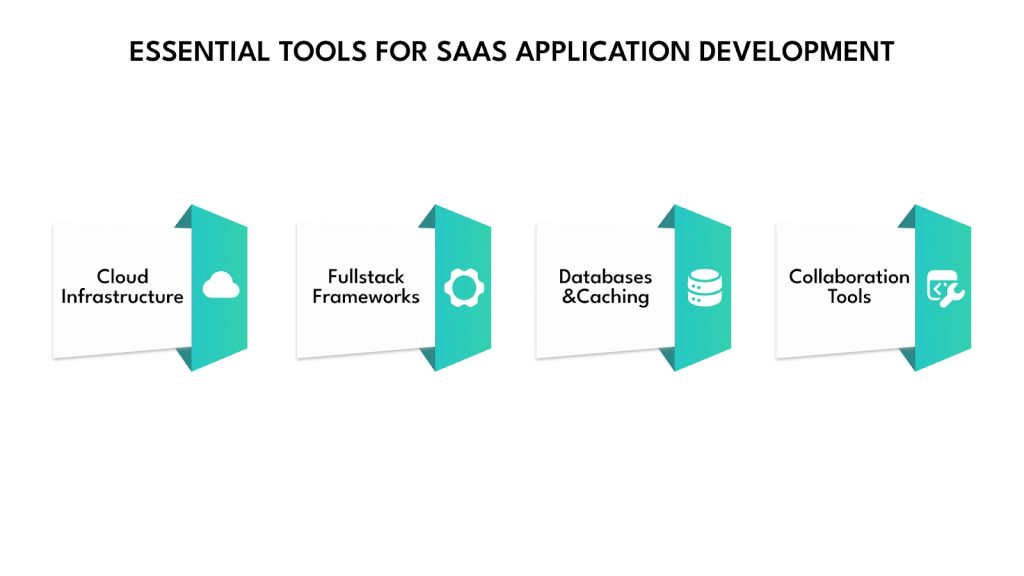
Your tech stack defines how fast you move and how well you scale. At DEVtrust, we use a modern toolchain built for speed, clean releases, and enterprise-level reliability. Here’s what powers it:
Cloud Infrastructure and Hosting
We build on leading cloud platforms like AWS, Azure, and Google Cloud, using services that support multi-tenancy, auto-scaling, and global availability. Containerization with Docker, managed through Kubernetes, ensures consistent deployment across environments and allows applications to scale on demand.
Backend and Frontend Frameworks
- Node.js (with Fastify or Express) and Python frameworks like Django or FastAPI power scalable, high-performance APIs.
- On the frontend, React and Vue.js support fast, modular interfaces with reusable components that speed up delivery and simplify maintenance.
Databases and Caching
- PostgreSQL handles structured, multi-tenant data with strong relational consistency.
- MongoDB supports flexible, document-based use cases where schema agility matters.
- Redis or Memcached reduces load times by caching high-traffic queries with low-latency access.
Development and Collaboration Tools
Version control is handled via Git-based platforms like GitHub, supporting CI/CD pipelines and automated testing workflows. We manage sprint planning, backlog tracking, and tech debt using tools like Jira or Linear, keeping execution tight and transparent.
The tools you choose affect how fast you build and how well your product scales. Your tech stack should support what you’re building, without causing delays later.
Once your tooling foundation is in place, it’s time to shift focus from planning to execution. What follows is a step-by-step breakdown of the SaaS development process, designed to help your team move with speed, clarity, and confidence.
Comprehensive SaaS Development Process
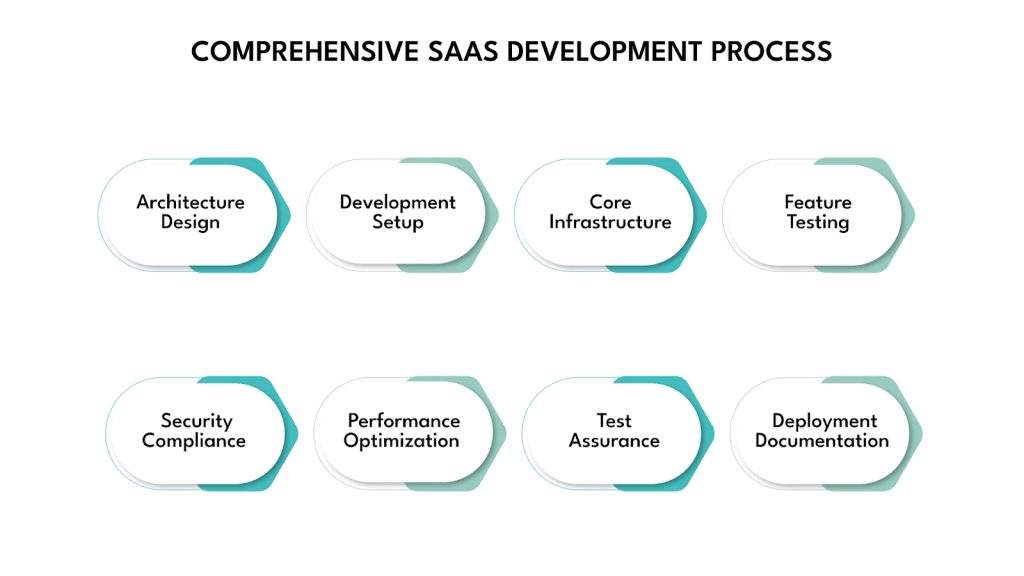
The SaaS development process follows a structured approach that balances speed-to-market with quality and scalability requirements. This methodology ensures that teams deliver functional software while building a foundation for long-term success.
1. Architecture Design and Technical Specification The process begins with designing the overall system architecture, including database schemas, API structures, and security models. This phase establishes the technical foundation that will support future growth and feature additions.
2. Development Environment Setup Teams configure development, staging, and production environments with identical configurations to ensure consistent behavior across deployment stages. This includes setting up continuous integration pipelines, automated testing frameworks, and deployment automation.
3. Core Infrastructure Development Initial development focuses on fundamental system components, including user authentication, data access layers, API frameworks, and security implementations. These core services provide the foundation for all subsequent feature development.
4. Feature Development and Testing Teams develop application features using iterative approaches that enable regular testing and validation. Each feature undergoes unit testing, integration testing, and user acceptance testing before integration into the main application.
5. Security Implementation and Compliance Security measures are implemented throughout the development process rather than added as an afterthought. This includes data encryption, access controls, audit logging, and compliance with relevant industry standards.
6. Performance Optimization Applications undergo performance testing and optimization to ensure they can handle expected user loads while maintaining responsive user experiences. This includes database optimization, caching implementation, and content delivery network configuration.
7. Integration Testing and Quality Assurance. Comprehensive testing validates that all system components work together correctly under various conditions. This includes load testing, security testing, and user experience validation across different devices and browsers.
8. Deployment Preparation and Documentation Teams prepare deployment procedures, create system documentation, and establish monitoring and alerting systems that will support production operations.
But building features is only half the job. SaaS products must deliver consistently under real-world pressure, which makes a strong QA process critical.
What Enterprise-Ready QA Looks Like in SaaS
SaaS quality assurance demands continuous testing across functionality, performance, security, and user experience, supporting an ongoing deployment operation rather than a one-time event.
Here’s how high-performing teams handle QA at the user level:
UX Testing That Reflects Real Roles
User experience testing focuses on real-world usage: task completion, error handling, and how different roles interact with the system.
A healthcare SaaS must work for clinicians and administrative staff. A logistics platform must support warehouse teams, dispatchers, and operations managers. Testing must reflect these real workflows, not just basic flows.
Cross-browser and device testing ensures consistency across screen sizes, inputs, and network conditions.
UI Testing Under Pressure
Interface testing covers layout behavior, form logic, and interactive elements across contexts. Accessibility checks ensure compliance with WCAG standards, essential for healthcare, education, or government clients.
Performance testing ensures UI elements stay responsive under load. Fast page loads, instant feedback, and real-time updates build trust, especially under peak usage.
Once your product passes QA, it’s time to ship, but in SaaS, deployment is an ongoing operation, not a one-time event. Stability, speed, and control all matter.
How Can You Deploy SaaS Products Without Disrupting Users?
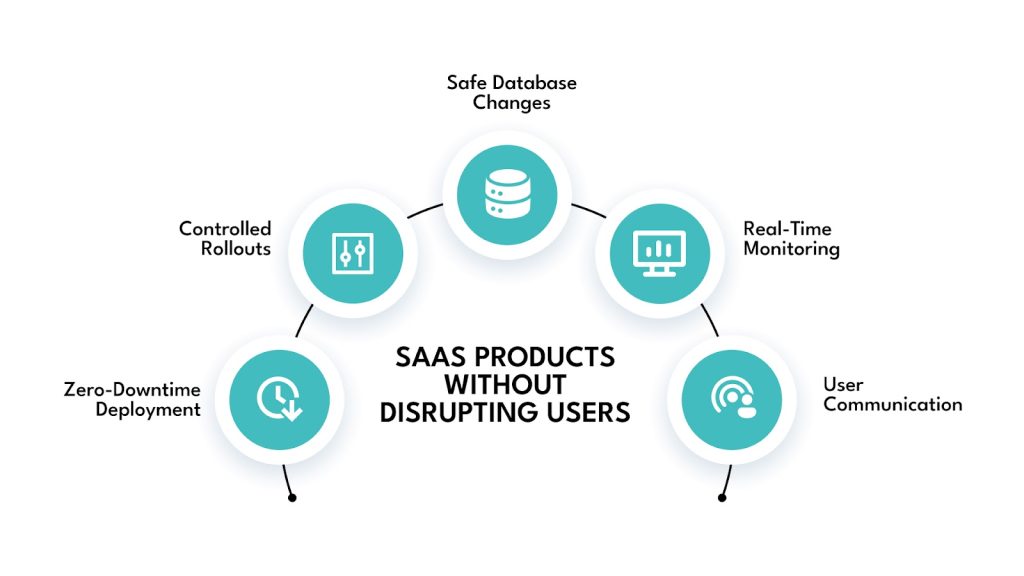
SaaS deployment requires coordination across infrastructure, product, and customer-facing teams. A strong release strategy must minimize user disruption, support fast rollback, and enable continuous delivery without compromising stability.
To achieve that, your deployment process should include these five core components:
- Zero-Downtime Deployment:Blue-green deployment maintains two live environments, one active, one idle. Teams deploy to the idle environment, validate functionality, and then switch traffic. If issues emerge, they can instantly revert to the previous version without downtime.
- Controlled Rollouts:Feature flags let teams release new functionality to specific user groups or segments. This staged approach reduces risk, supports A/B testing, and allows for faster iterations based on real feedback.
- Safe Database Changes:Database migrations should follow phased, backwards-compatible strategies. This ensures schema changes or data transformations do not disrupt running applications, especially during live deployments.
- Real-Time Monitoring: Monitoring and alerting systems track performance, error rates, and user behavior. These tools help engineering teams catch and resolve issues before they impact end users.
- User Communication:Proactive communication plans inform users about upcoming changes, maintenance windows, or new features. Clear messaging reduces confusion, builds trust, and cuts down on support tickets.
Building a stable release process takes the right structure. If you’re mapping yours out, DEVtrust can help you get it right from the start. Reach out to us when you’re ready to move forward.
What Does It Take to Keep a SaaS Product Running Smoothly Post-Launch?
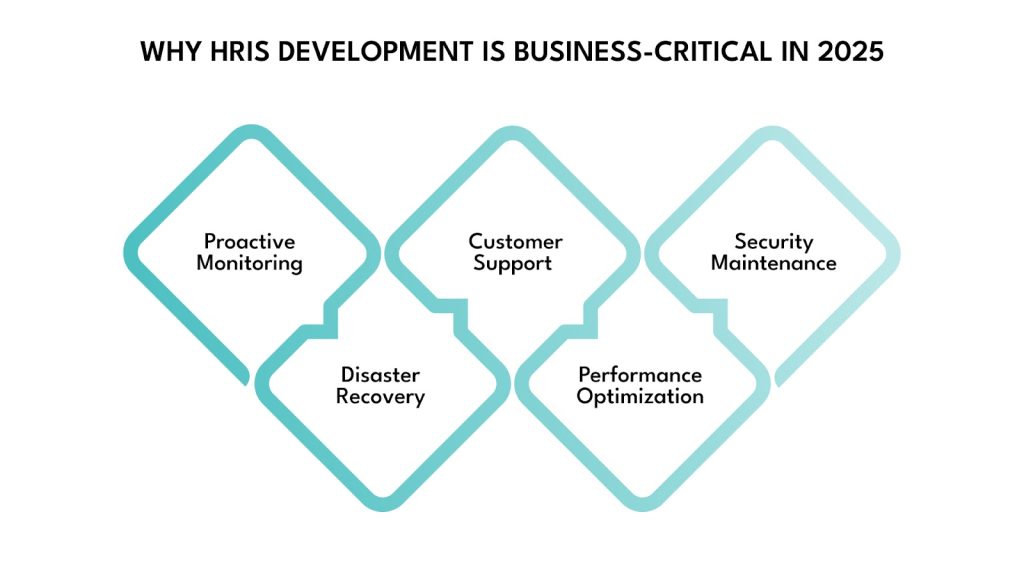
Shipping your SaaS product is just the beginning. Sustained performance, security, and user satisfaction depend on how well you maintain and optimize operations. This phase is where long-term customer retention is won or lost.
To maintain operational excellence, your team must stay proactive across these key areas:
Proactive Monitoring
Monitoring tools should continuously track system performance, security risks, and user behavior. Metrics like response time, error rates, and resource consumption help surface issues before they affect users or reveal patterns that suggest new opportunities.
Reliable Backup and Disaster Recovery
Automated backups and well-documented recovery procedures are critical. Maintain multiple backup versions, regularly test restoration workflows, and ensure business continuity with minimal downtime in case of failure.
Scalable Customer Support
Support systems must offer clear documentation, fast response times, and multiple contact channels. High-quality support reduces churn, boosts satisfaction, and creates feedback loops that inform future product improvements.
Performance Optimization
Continuous performance tuning is non-negotiable. From database indexing and code refactoring to infrastructure scaling and UI enhancements, every improvement must be validated to ensure measurable impact.
Ongoing Security Maintenance
Security requires continuous efforts such as regular patching to fix vulnerabilities, vulnerability scanning to detect threats, and compliance audits to ensure adherence to regulations, all crucial for protecting user data as the product evolves.
What Does End-to-End Security and Compliance Look Like in SaaS?

Security in SaaS extends beyond password protection to include multiple layers such as data encryption, strict access controls, and adherence to regulations. This comprehensive approach is critical given the recent surge in SaaS-specific breaches.
Below are the core pillars of a modern SaaS security and compliance strategy:
1. Multi-Layer Data Encryption
SaaS applications must secure data in transit, at rest, and in use.
- TLS certificates protect data in motion.
- At-rest encryption secures stored information in databases or file systems.
- Field-level encryption protects sensitive fields like payment data or health records.
- Key management policies must define rotation cycles, storage, and access auditing to avoid single points of failure.
2. Identity and Access Management (IAM)
Access must be strictly governed by roles and risk levels, not convenience.
- Role-Based Access Control (RBAC) ensures users only access what they need.
- Multi-Factor Authentication (MFA) adds a second verification layer.
- Session controls help limit exposure during long user sessions or inactivity.
3. Continuous Vulnerability Testing
Security is not static. You need an ongoing assessment.
- Automated scanning catches known threats at scale.
- Manual penetration testing detects SaaS-specific attack paths like privilege escalation or insecure integrations.
- Remediation cycles should be documented and enforced as part of dev sprints.
4. Incident Response Readiness
Even with strong prevention, incidents can still happen. A response plan is your last line of defense.
- Automated threat detection flags anomalies in real time.
- Escalation protocols ensure fast handoff across teams.
- Communication playbooks guide internal and external messaging.
- Post-incident reviews convert failure into prevention.
Once your SaaS product is stable, the focus shifts to what’s changing—new technologies, user demands, and what your roadmap needs to account for next.
What Emerging Trends Will Shape the Future of SaaS Development?
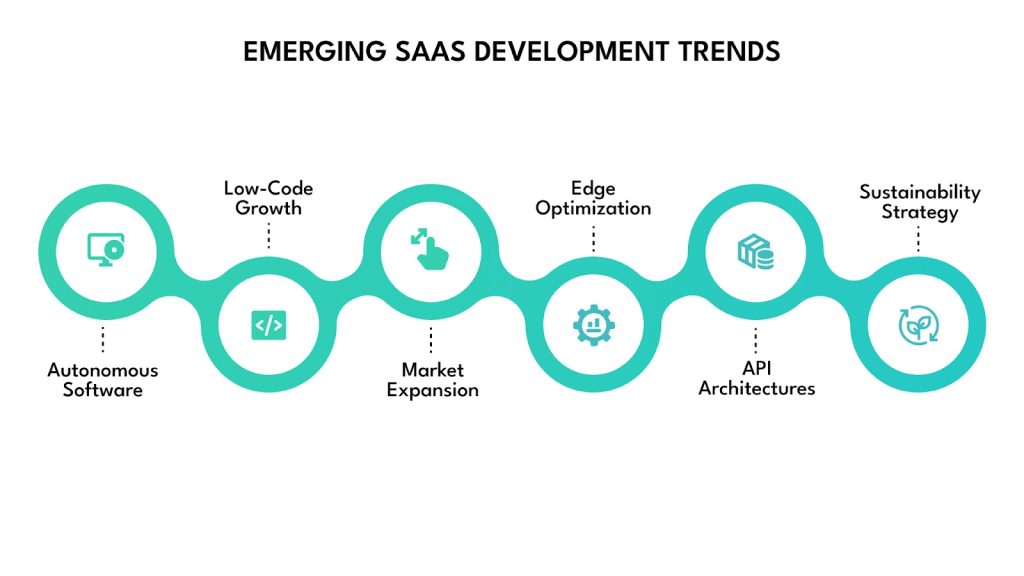
To stay competitive, SaaS leaders must anticipate how technology and customer expectations are evolving. These six trends are redefining what successful SaaS products will look like in the next five years—and the smartest teams are already preparing.
1. Agentic AI and Autonomous Software Behavior
AI is moving beyond recommendation engines into autonomous agents that can plan, decide, and execute tasks without direct input.
- Agentic AI is driving sharper automation across high-volume workflows. These systems assist, make decisions, and execute tasks with minimal human input.
- In accounting SaaS, agents can auto-categorize expenses, detect anomalies, reconcile records, and prepare compliance reports with minimal oversight.
- For support platforms, AI agents can prioritize tickets, generate replies based on conversation history, and escalate urgent issues without waiting for human review.
- SaaS teams should explore embedding such agents into customer-facing and internal workflows where speed, accuracy, and scalability are crucial.
2. Rise of Low-Code and No-Code Platforms
In 2025, 70% of app development will use low-code/no-code tools.
- This opens new market segments, non-technical teams, business users, and fast-moving departments.
- SaaS products should consider embedding builder tools or offering integration with LCNC platforms.
3. Explosive Market Growth
The SaaS market is projected to grow from $208Bin 2025 to $716B by 2030.
- Growth means opportunity, but also increased competition
- Differentiation, extensibility, and ecosystem partnerships will become critical levers
4. Edge Computing for Global Performance
Processing at the edge improves latency and reliability for real-time or mobile-first applications.
- Ideal for SaaS tools involving IoT, field teams, or real-time collaboration
- Developers should evaluate edge deployment strategies early in their scaling plan.
5. API-First Architectures
APIs are no longer just a feature; they’re a product foundation.
- An API-first approach enables integrations, developer ecosystems, and modular platforms
- Consider how your product can serve not just users, but builders and partners
6. Sustainability as a Competitive Advantage
Customers are increasingly choosing software that aligns with environmental goals.
- Energy-efficient infrastructure and carbon transparency reporting may soon be differentiators.
- Building in sustainability now can lead to long-term trust and regulatory alignment.
Conclusion
SaaS development involves a series of critical decisions, including architecture, compliance, release strategy, and pricing. Miss one, and it shows up fast.
And that’s where most teams run into trouble. It’s rarely the code that breaks things; it’s the architecture shortcuts, unclear requirements, or rollout issues that hit hard when it’s too late to adjust. We’ve seen it happen at 500 users, at 5,000, and everywhere in between.
At DEVtrust, we work closely with teams early on, before the fires start, to build stable and scalable platforms from day one. If your build feels messy, slow, or uncertain, we’ll help you fix the gaps fast.
Struggling with scale or performance? Talk to us, and our team will help you pinpoint and fix what’s slowing you down.
Complete Guide to SaaS Development Process: From Concept to Launch
Ready to streamline your SaaS development? Discover comprehensive steps like planning, architecture design, and QA testing. Start building better SaaS today!
Contact Us


